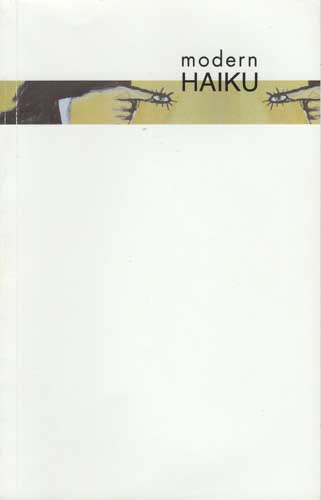Modern Haiku – Summer 2014
Last month I reviewed Frogpond and noted it as one of THE journals for haiku enthusiasts. Modern Haiku is another of THE journals haikuists should be reading. This journal has been in continuous print since 1969, with a masthead of esteemed haiku experts, each a haiku household name: Kay Titus Mormino, Robert Spiess, Lee Gurga, Charles Trumbull, and the current editor, Paul Miller.
Last month I reviewed Frogpond and noted it as one of THE journals for haiku enthusiasts. Modern Haiku is another of THE journals haikuists should be reading. This journal has been in continuous print since 1969, with a masthead of esteemed haiku experts, each a haiku household name: Kay Titus Mormino, Robert Spiess, Lee Gurga, Charles Trumbull, and the current editor, Paul Miller.
Modern Haiku publishes all forms, combining haiku and senryu as well as essays, both scholarly and personal, a “poetry gallery” featuring full color haiga forms, and haibun. I suggest reading through the haiku & senryu over several days to slowly savor the power of each—with nearly 100 works on these pages alone, readers need to pace themselves.
The essays are my favorite part: learning from experts, considering perspectives relevant to current conversations and arguments about Japanese poetic forms. I was skeptical (pun intended) of this issue’s topic: “UFOs in Haiku” by Jim Kacian, adapted from an article first presented in 2013 at Haiku North America in California. The fact that it begins: “The aliens have landed and they’re infiltrating haiku” did not instill confidence that this was going to be a rigorous concept discussion. But when reading the definition: Unique Formal Objects, and goal of the article “to help you recognize these elusive entities, possibly with an eye toward helping you create your own,” I was all in. Kacian explores those forms of presentation which break our (Western) traditional expectation of haiku as a three line form, tracing the first known sightings of such UFOs, and showing how form changes became normalized (such as the one-line form, now seen as nothing unique). Kacian examines why writers might choose these unique presentations and how form affects meaning. He addresses how in some cases, these forms create arguments as to whether or not they are still haiku (Kacian repeatedly argues on the “yes” side of that issue).
Having read the essay, I could not look at the remainder of the works in the journal the same way. Far from being a distraction, my reading was slowed even more as I considered each presentation, how author decisions on unit, form and order impacted meaning, how it could have been different. It’s almost as if I couldn’t believe I hadn’t read with such clarity before—I had been missing so much!
John Stevenson’s essay, “Poetry as a Sense Organ,” is barely two pages of personal reflection but tremendously enlightening as he recounts his hiatus from writing to his re-immersion. He considers his own “poem making as a sixth sense organ”:
My understanding of life involves the acuity and also the limitations of my senses. I touch, taste, listen to, and inhale what is around me in order to understand it and thrive in it as best I can. And, in a sense, I also experience my surroundings by ‘poeming’ selected portions of them.”
For any writer who has taken hiatus (or is currently), you’ll find a kindred spirit in this work.
This issue of Modern Haiku also includes a special section on Punjabi Haiku—translations by Amarjit Sathi Tiwana and Arvinder Kaur. Punjabi haiku has really taken off in the past ten years, with Tiwana sharing haiku and building popularity for it via his WordPress page and now Facebook group (with over 4000 members). The collection presented in this issue comes from the blog and Facebook group. Though many of these could be read as “any culture” haiku, it’s a much deeper read to know cultural place and be able to sense the poems geographically. Like Stevenson says, the images of these works reach us in a sixth sense of knowing—image lines like “from her shawl” (Kulpreet Badial), “a deserted library—” (Davinder Singh Poonia), “the temple lights dance” (Ranjit Singh Sra), “fallen mud house—” (Ravinder Ravi), “a sandalwood fragrance” (Jagjit Sandhu), and “scent of mangoes—” (Anoop Babra). Our ability to receive these images in a more specific cultural context strengthens their meaning, deepens the reader’s experience with them, and allows for shared experience.
The Robert Spiess Memorial Haiku Award Competition for 2014 winners are included in this issue along with commentary on each from Roberta Beary, judge, and Billie Wilson, contest coordinator. In all, an outstanding issue of Modern Haiku, which is exactly what you’ll get each time you pick up this journal.
[www.modernhaiku.org]





